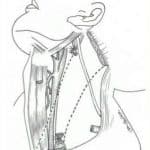Table of Contents
What is Modified radical neck dissection (MRND)?
Modified radical neck dissection is a surgery to remove most of the lymph nodes between the jawbone and collarbone on one side of the neck. It can cause notable changes in the appearance of your neck and the function of the shoulder joint.
What is the need for MRND?
- Treatment for head and neck cancers (oral, oropharyngeal, hypopharyngeal, and laryngeal)
- To treat high burden of lymph node metastases
Questions to ask your doctor
- Do you have other options to treat my condition?
- What additional treatment will I need?
- How will it affect my speech and swallowing?
- What assistance will I need at home?
Risks and complications of surgery
- Bleeding
- Infection
- Fluid accumulation in the neck
- Delayed wound healing
- Scarring of incisions
- Numbness
- Neck stiffness or pain
- Severe swelling
- Lymphedema
- Shoulder weakness
- Changes in speech and swallowing
How is the surgery done?
Duration of surgery
The surgery takes between 3-6 hours. Most patients may spend 4-5 days in the hospital.
Before procedure
- Do not eat or drink anything the night before the surgery
- Stop taking blood thinners before the procedure.
- Ask your physician about medicines you can take before the surgery
- Inform your physician if you are or could be pregnant
During procedure
You will be asleep on the surgical table due to anesthesia.
The surgeon will –

- Make a cut that creases the neck, extending vertically on the side of the neck. Incisions enhance the visualization and protection of essential neck structures. It helps the safe removal of cancer-associated lymph nodes
- Identify and remove the tissue containing the lymph nodes. Removal of sternocleidomastoid muscle may cause flattening of the neck
- Place wound drains to remove excess blood or lymph fluid
- Stitch the incision and apply paper tape to the area
After procedure
A nurse will –
- Move you to the recovery room after surgery
- Assist you in moving around on the day of the surgery. Start physical therapy in the hospital and continue at the home
You will –
- Have an IV tube for receiving fluids and nutrition because you may not be able to drink or eat for the next 24 hours
- Receive pain medicine and antibiotics via IV tubes for the next few days
- Have drains in your neck
- Have staples or sutures around the wound
- Also, have mild swelling for the few weeks after surgery
Caring for yourself after surgery
- Clear the drain output daily
- Apply antibiotic cream to your wound
- Showering is preferable to bathing
- Do not use tobacco products
- Avoid trauma to the incision, heavy lifting, or strenuous activity
- Keep your head elevated while sleeping. Use two or more pillows or raise the head of the bed
- Avoid foods that are hard to chew
- Take pre-operative medications unless otherwise specified
When to Call the Doctor?
- Fever above 101.5 degrees
- Increase in swelling and warmth
- Severe pain
- Redness at the neck incision site
- Hemorrhage (Bleeding)
- Discharge from the wound
- Development of any medication allergies
